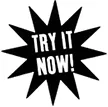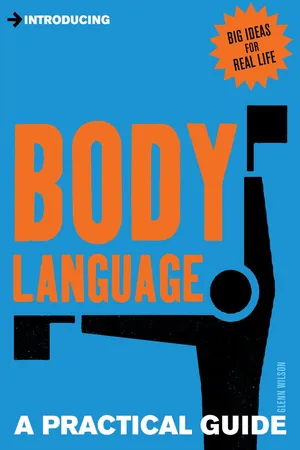1. Everybody’s second language
Fie, fie upon her!
There’s language in her eye, her cheek, her lip.
Nay, her foot speaks: her wanton spirits look out
At every joint and motive of her body.
Ulysses, in Shakespeare’s Troilus and Cressida
I speak two languages – Body and English.
Mae West
There are many jokes about dogs that talk. They are funny because we know that dogs don’t talk. Or do they? Dog owners know that Fido can express himself quite effectively in a variety of ways. He can wag his tail and bark excitedly when anticipating food or walkies. He can lower his head and cower as though expecting to be hit when feeling guilty about stealing some sausages. These emotions are readily understood by dog owners. Fido can also glean a great deal about how we are disposed towards him from our gestures and behaviour. Although he might be responsive to the shape of certain words, such as his own name, most of this communication is through the reading of body language and tone of voice.
Humans don’t have to rely on such indirect signals because we have an advanced language capability and can state our case much more clearly and explicitly. At least we think we can.

In some ways, body language is even more highly developed in humans because we have a most expressive face that has developed in connection with our preferred front-on interaction. Powerful signals are transmitted by facial expressions. We also have a highly developed capacity for ‘mind-reading’. This is the very useful capacity to second-guess what somebody has ‘in mind’ for us based on voice inflexions and body language cues. Obviously it is important to know whether or not someone fancies us or wishes we would just go away. It is important to know whether they are on-side or on the verge of attack. Mind-reading ability has been retained and in some ways further evolved in humans because it has considerable survival value.
Where there is a discrepancy between what is said verbally and the feelings that are indirectly transmitted through facial expression and body language, we quite rightly set greater store by what we see, rather than what we are being told. This is because body language ‘leaks’ certain emotions and attitudes that we might have preferred to conceal from those who observe us (and they know it). The reception process is immediate and largely unconscious, though it can be made conscious through a process of analysis such as that used in this book.
It is widely said that 93% of our communication is through body language, while only 7% is based in the words themselves. Although Albert Mehrabian, the researcher on whose work in the 1960s this assertion is based, has said this is a simplification of his findings, others have produced data suggesting that around 60–70% of our communication is non-verbal.

It is now widely recognised that what we often think of as our second language is actually of more importance than our first. Any poker player, salesperson, investigating detective, actor or nightclub dancer will attest to this, so it is important to study it and understand its principles.

Next time you are at a noisy cocktail party or social function where you can barely hear the person you are talking to, take a look at groups of people interacting across the other side of the room. Even though you cannot hear a word they say, you will be able to divine a great deal about what is really going on between them and their true feelings and intentions towards each other. Perhaps one is making a play for the other that you can tell is unwelcome and will come to nothing. One may be clearly dominant over the others because the others are all respectful and attentive towards that individual. In a funny way, you can often tell more about the real relationships among people when you are not distracted by the content of the ‘small talk’ that is going on between them.
But how can you ever know if you were right? The same effect can be achieved by turning off the sound on the TV when a drama or soap is playing. An amusing party game is to supply some of the dialogue that you cannot hear on a video, then afterwards replay it with the sound up to see how far wide of the mark you were. At the very least, you will probably have been right about which characters were at loggerheads and which were enjoying warm rapport. If you were wrong, was it bad acting, or was there some additional agenda or undercurrent that might explain why the words were inconsistent with the body language?
Deaf people are particularly good at the body language game (even without lip-reading) because they have more experience at the skill. The American performance artist Terry Galloway, author of the book Mean, Little, Deaf, Queer (2009), reported on her own experience of going deaf in early childhood as a side-effect of an antibiotic: ‘Deafness has left me acutely aware of both the duplicity that language is capable of and the many expressions the body cannot hide.’ There is also some evidence that women are better at reading body language than men, which is the truth in the phrase ‘women’s intuition’.
The beast within
What is the origin of this non-verbal code to which we are all responsive? The great evolutionary biologist Charles Darwin pointed out that the expression of an emotion is usually achieved by delivering a sample or residue of a more complete and overt instinctive behavioural pattern.
‘Disgust’ literally means rejecting something that is foul tasting. Even though it may be induced by social events, the facial expression of disgust still resembles regurgitation of tainted food. Fear is indicated in various ways: by freezing, by preparing to flee or by clinging hold of someone/something for support. Such strategies might be of value when confronted with a lion in the wild but they are less appropriate when the source of ‘danger’ is an audience to whom we have to make a speech. This is why ‘stage fright’ is something we try to overcome.
A dog snarls in anger as a threat to bite. In much the same way, when humans are angry they show preparation to fight. They clench their teeth, make a fist with their hand and thrust their head forward. They may not actually be about to bite, punch or butt the other person but they are indicating that they are inclined to. Body language enables us to make threats to others that, if properly received and responded to, can deflect actual aggression. In this way competitor males do not necessarily have to fight to the death to establish dominance. A ritual struggle will do instead. Of course, it doesn’t always work: sometimes the mere act of looking at another person is seen as aggressive and violence is provoked, especially among testosterone-fuelled young male gangs. But for much of human interaction a show of anger may be sufficient without the need for actual violence.

Cross-cultural accord
Many emotional expressions are universal across cultures. For example, people throughout the world smile and laugh when happy, and they cry or frown when sad. In all places, the ‘eyebrow flash’ (lifting the eyebrows in pleasant surprise) is used when greeting an old friend that one has not seen in a long time. Even monkeys do this, confirming the evolution of our body language. Turning the head from side to side means ‘no’ in any culture and anthropologists trace this to the suckling baby turning its head away from its mother’s breast when it has had enough milk.
The tendency of women to make brief eye contact with a man and then avert their gaze away and downward is observed even in little girls born blind. This means that it could not have been acquired through imitation. While we might think of it as a display of female modesty, some anthropologists interpret this behaviour as a ritual invitation to chase, the expectation being that they would eventually be run down and caught by a ‘fit’ male. This is why gaze-averting comes across as a flirtatious gesture. The courting male would thus be tested both for his determination and his physical fitness, attributes that would be useful in any offspring that might result from mat...
